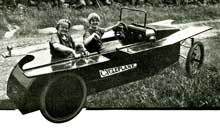The Cycleplane
Cyclecars were all the rage in 1914. It started in France with the Bedélia and spread to Britain where the GN became popular on the road and on the race track. They were cheap to buy and inexpensive to operate, so soon the fad spread to the United States.
Soon such gangly creatures as the Cricket, the Greyhound, the Dudly Bug and the O-We-Go were on the roads. James Scripps Booth put his Rocket into the fray. With a cyclecar, one didn't need a garage, nor a driveway.
Into this milieu rode Arthur W. Ball, MD, of Westerly, Rhode Island. Dr. Ball's entry in the cyclecar derby was the Cycleplane, a tandem-seat car powered by a V-twin engine and belt drive. The "aeroplane mudguards" were said to act as shock absorbers. The company, headquarters were at 42 Canal Street, Westerly, now a hotel and retail spaces, and the car's slogan was "Rides over the dust." The Tourist model was to sell for $450. In August 1914, Cyclecar Age reported that his "1915 model" had been "ready July 10." Dr. Ball's son remembered that only one car was built, and that it left town on a railroad flatcar.
This did not stop Dr. Ball from trying to promote it. He talked a machinist named Christie McConnell into purchasing the rights to manufacture the Cycleplane out of parts to be purchased from the good doctor himself, but nothing came of it.
By 1915, the price of a Model T, a real car, had dropped to $440, making the $450 Cycleplane an unattractive buy. And then to put the final nail in the cyclecar's coffin, Henry Ford trotted out his own small version of the T and displayed it in front of Detroit's Pontchartrain Hotel. He never put it into production. He didn't have to. He merely needed to demonstrate that he could, and all the cyclecar makers folded.

